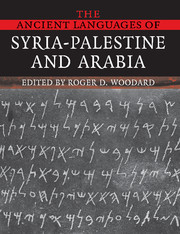Book contents
- Frontmatter
- Contents
- List of figures
- List of tables
- List of maps
- List of contributors
- Notes on numbering and cross-referencing
- List of abbreviations
- Preface
- Preface to the first edition
- Map
- 1 Language in ancient Syria-Palestine and Arabia: an introduction
- 2 Ugaritic
- 3 Hebrew
- 4 Phoenician and Punic
- 5 Canaanite dialects
- 6 Aramaic
- 7 Ancient South Arabian
- 8 Ancient North Arabian
- Appendix 1 Afro-Asiatic
- Appendix 2 Full tables of contents from The Cambridge Encyclopedia of the World's Ancient Languages, and from the other volumes in the paperback series
- Index of general subjects
- Index of grammar and linguistics
- Index of languages
- Index of named linguistic laws and principles
4 - Phoenician and Punic
Published online by Cambridge University Press: 22 September 2009
- Frontmatter
- Contents
- List of figures
- List of tables
- List of maps
- List of contributors
- Notes on numbering and cross-referencing
- List of abbreviations
- Preface
- Preface to the first edition
- Map
- 1 Language in ancient Syria-Palestine and Arabia: an introduction
- 2 Ugaritic
- 3 Hebrew
- 4 Phoenician and Punic
- 5 Canaanite dialects
- 6 Aramaic
- 7 Ancient South Arabian
- 8 Ancient North Arabian
- Appendix 1 Afro-Asiatic
- Appendix 2 Full tables of contents from The Cambridge Encyclopedia of the World's Ancient Languages, and from the other volumes in the paperback series
- Index of general subjects
- Index of grammar and linguistics
- Index of languages
- Index of named linguistic laws and principles
Summary
HISTORICAL AND CULTURAL CONTEXTS
Phoenician is a member of the Semitic language family, specifically the Northwest Semitic branch of Central Semitic. Within Northwest Semitic it is a Canaanite language, the closest relatives of which are Hebrew, Moabite, Ammonite, and Edomite.
Phoenicia
A description of the sources for the Phoenician language depends to a certain extent on what “Phoenician” is held to mean. The term “Phoenicia” is generally reserved for the strip of land sixty miles long (from Acco in the south to Tell Sukas in the north) and at most thirty miles wide, on the northern coast of the Levant, bounded on the west by the Mediterranean and on the east by the Lebanon Mountains – that is, the modern coast of Lebanon and part of the northern coast of modern Israel. As a scholarly convention, this area is referred to as Phoenicia after 1200 BC, the beginning of the Iron Age. In the early Iron Age, the ravages of the so-called Sea Peoples along the coast of ancient Canaan and into Egypt forced the withdrawal of Egyptian control over Canaan. This withdrawal allowed the Philistines and other Sea Peoples to gain control over the southern coastal plain, and even to expand eastward, where they met a westward-expanding Israel.
- Type
- Chapter
- Information
- The Ancient Languages of Syria-Palestine and Arabia , pp. 82 - 102Publisher: Cambridge University PressPrint publication year: 2008
- 5
- Cited by

